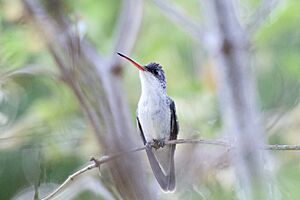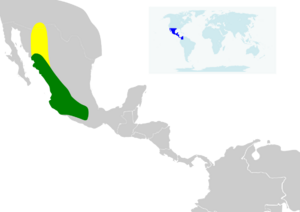Violet-crowned hummingbird facts for kids
Quick facts for kids Violet-crowned hummingbird |
|
|---|---|
 |
|
| Conservation status | |
| Scientific classification | |
| Genus: |
Ramosomyia
|
| Species: |
violiceps
|
 |
|
| Synonyms | |
|
Cyanomyia violiceps, Leucolia violiceps, Amazilia violiceps |
|
The violet-crowned hummingbird (Ramosomyia violiceps) is a small, colorful bird. It is a type of hummingbird known for its bright head. You can find this bird in Mexico and the southwestern United States.
Contents
About the Violet-Crowned Hummingbird's Name
Scientists group living things to understand them better. The violet-crowned hummingbird's scientific name has changed a few times. It used to be in a group called Amazilia.
Later, new studies looked closely at its DNA. These studies showed that the Amazilia group needed to be reorganized. So, the violet-crowned hummingbird was moved to a new group called Leucolia.
Even more recently, in 2021, scientists found that Leucolia wasn't the best name to use. They suggested a brand new group called Ramosomyia. In 2022, many bird experts agreed to use Ramosomyia. This is why its full scientific name is now Ramosomyia violiceps.
There are two slightly different types, or subspecies, of the violet-crowned hummingbird. These are called R. v. violiceps and R. v. ellioti.
What Does the Violet-Crowned Hummingbird Look Like?
This hummingbird is about 10 to 11.5 centimeters (4 to 4.5 inches) long. It weighs around 5.1 to 5.8 grams (0.18 to 0.20 ounces). That's about the weight of two pennies!
Both male and female birds have a bright red beak. Sometimes the tip of the beak is black.
Male Birds
Male birds of the main type (R. v. violiceps) have a very bright violet-blue crown, which is the top of their head. The back of their neck is also bluish-violet. Their back and rump are dull grayish-brown or greenish-brown. Their tail feathers are a coppery bronze color.
The underside of their body, from their throat to under their tail, is pure white. Their sides have light olive-green feathers.
Female Birds
Female birds look very similar to males. However, their colors are usually a little less bright overall.
Subspecies Differences
The other type, R. v. ellioti, looks much like the main type. But the males of R. v. ellioti have a crown that is more turquoise-blue. Their tail is also more greenish-bronze. Again, the females of this type are almost identical but duller.
Where Do Violet-Crowned Hummingbirds Live?
The R. v. ellioti subspecies lives further north. You can find it in southeastern Arizona and southwestern New Mexico. It also lives south into Mexico, in states like Michoacán and Hidalgo. It might even be found in Puebla and México states.
In Arizona and New Mexico, these birds usually live between 1,200 and 1,700 meters (3,900 and 5,600 feet) high. In Sonora, Mexico, they live at lower heights, from 200 to 1,300 meters (660 to 4,300 feet).
The R. v. violiceps subspecies lives in eastern and southern Michoacán, south into northwestern Oaxaca. In this southern area, they are often found between 200 and 1,400 meters (660 to 4,600 feet) high. But they can live anywhere from sea level up to 2,400 meters (7,900 feet).
These hummingbirds live in many different places. They like areas near rivers and streams in dry, thorny forests. They also live in forests with pine and oak trees, open fields, fruit orchards, and even parks and gardens in towns.
Violet-Crowned Hummingbird Behavior
Movement and Migration
Many violet-crowned hummingbirds in the U.S. and northern Mexico move south for winter. This is called migration. However, some birds stay in Arizona all year long.
More and more of these birds are being seen in the U.S. This suggests they might be slowly moving their living area further north. Birds in southern Mexico usually stay in the same place. They might move short distances to find food.
Feeding Habits
Violet-crowned hummingbirds eat nectar from flowers. They hover in the air while they drink. They visit many different kinds of flowering plants and bushes.
When there are lots of flowers, these hummingbirds usually feed peacefully. But if flowers are scarce, they might try to protect their favorite flower patches. They will chase away smaller hummingbirds.
Besides nectar, they also eat small insects. They catch insects by flying out from a perch, which is called "hawking." They also pick insects off plants while hovering.
Reproduction and Nesting
In Arizona and New Mexico, violet-crowned hummingbirds lay eggs from April to September. They often build their nests in Arizona sycamore trees.
In Mexico, they usually nest between March and August. However, they have been seen nesting at almost any time of the year. We don't know much about their nesting habits in Mexico.
Their nests are usually shaped like a cup. They are made of soft plant material held together with spiderwebs. They often have bits of lichen on the outside. Most nests have two eggs. Scientists don't yet know how long the eggs take to hatch or how long it takes for the baby birds to leave the nest.
Vocalization (Sounds)
The song of the violet-crowned hummingbird is described as a series of very high, thin, notes. It sounds like "seew seew seew seew seew" going down in pitch. They sing this song from a branch where they can be seen.
They also make different calls. One call sounds like a dry "tak" or "chap." Other calls are described as a hard "chip", "stik", or "tik." They make many other sounds when they are interacting with other hummingbirds.
Conservation Status
The IUCN (International Union for Conservation of Nature) says the violet-crowned hummingbird is a species of "Least Concern." This means they are not currently in danger of disappearing.
They live in a very large area. Scientists estimate there are about two million adult birds. This number seems to be staying steady. There are no major threats to this bird right now.


